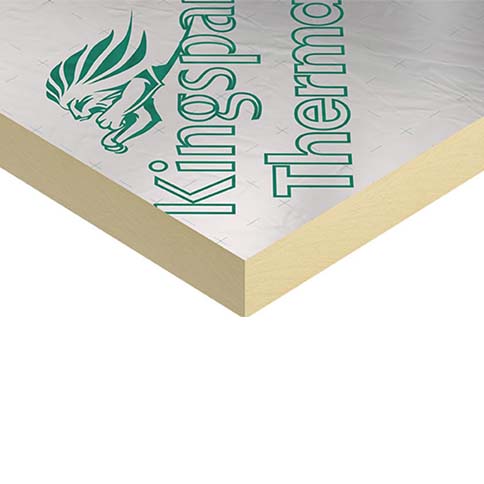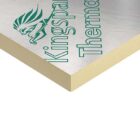Description
Kingspan TF70 30mm
Get the best prices on Kingspan insulation boards here! Thermafloor TF70 30mm is a quality product made up of a 2400mm by 1200mm rigid thermoset polyisocyanurate (PIR) core with a low emissivity foil facing bonded to each side to provide high thermal quality. TF70 is manufactured with Niflam technology.
- Kingspan as a brand is renowned for its top-quality products and wide range of products
- Kingspan now has 129 manufacturing sites in over 70 countries around the world and is still growing
- Their brand is also known for its sustainability and their commitment to tackling climate change
- Their products all provide the ultimate top-class performance and offer incredible reliability
- The Kingspan brand offers materials to suit a wide range of applications including, pitched roofs, flat roofs, walls, floors, and ceilings
- Kingspan provides high-performance thermal insulation solutions for both residential and commercial buildings
30mm Kingspan Thermafloor TF70
- 30mm TF70 boards are one of the most used products within the construction industry and is well-known for the incredible quality
- The TF70 insulation boards have a straight edge to ensure boards can be tightly butted together to avoid thermal bridging
- The 30mm board is for its thinner size, the 30mm can be installed within spaces that contain a smaller cavity which ensures you make the most of you working and living space
- The low emissivity foil facings are on each side of the board. This reflective, low emissivity surface improves the thermal resistance of any unventilated cavity adjacent to the board
- Kingspan TF70 means you can improve the thermal quality within the internal structure of the building’s envelope. The boards are also unaffected by air filtration
- TF70 insulation Boards are lightweight making them super easy to handle, cut, and install. This product will make a projects turnaround times quicker than ever
- This board offers an incredible thermal conductivity of just 0.022W/mK – which for those who don’t know, means very small amount of heat can pass through the board, keeping the heat inside your home or office!
- Whilst staying warm in the winter and cool in the summer, you’re also providing an energy efficient environment that contributes to the reduction of climate change
- While you think it stops at helping the environment, with less heat escaping, Kingspan TF70 boards can also save you money on your energy bills
- All Cavity boards are CFC, HCFC and Formaldehyde Free with zero ozone depletion potential (ODP) and low global warming potential (GWP)
- Kingspan Thermafloor TF70 resists attack by mould and microbial growth, and do not provide any food value to vermin, helping to maintain the condition of the buildings structure
30mm TF70 Applications
TF70 30mm is named Thermafloor however it can be used in a variety of application types within domestic and commercial buildings. This includes roofs, walls, and floors. More specifically TF70 30mm can be used for flat roofs, pitched roofs, solid masonry walls and floors as well as timber framed & steel framed systems. Full application types can be found below:
Ground Floor – Concrete Slab
Ground Floor – Suspended Timber Joist
Ground Floor – Beam and Block
Ground Floor – Over joists
External Wall – Between joists
External Wall – Inside Studs
Pitched Roof – Over Timber Rafters
Pitched Roof – Sarking
Pitched Roof – Below Timber Rafters
Pitched Roof – Between Timber Rafters
Pitched Roof – Loft insulation – Between and Over Timber Joists
Flat Roof – Balconies & Terraces Over Joists
Flat Roof – Between Timber Joists
Flat Roof – Below Timber Joists
Safety:
- ISO 9001: 2015 (Quality Management Systems)
- ISO 14001: 2015 (Environmental Management Systems)
- ISO 45001: 2018 (Occupational Health and Safety Management Systems)
- ISO 50001: 2018 (Energy Management Systems)
- BBA Certificate 14/5133
- Fire Euroclass rating of F
How are Kingspan Thermafloor TW70 insulation boards installed in the floor?
- Ensure the site is prepared and foundations, where appropriate, built to damp proof course (DPC) level. A thin sand blinding may be used to achieve a continuous smooth level surface, free from projections.
- The damp proof membrane (minimum 300 micron / 1200 gauge polythene) should be laid with joints well lapped and folded, to prevent the passage of water, prior to laying the insulation boards. The membrane should be brought up the surrounding walls until it is sufficiently above the height of the walls Damp Proof Course so that it will connect with or form the DPC.
- The insulation boards should always be loose-laid break bonded, with joints lightly butted together. If two layers of insulation are required, the next layer should be horizontally offset to the previous layer, the board joints in the two adjacent layers should not coincide with each other. See image below.
- A strip of the insulation board (minimum 20 mm thick) should be placed vertically around the outside of the floor slab in order to prevent cold bridging. The top of the strip of insulation board should be level with the top of the floor screed and the bottom should be level with the bottom of the horizontal floor insulation, and closely butted up to it with no gaps.
- Insulation boards should be overlaid with a polythene sheet (not less than 125 micron / 500 gauge), to prevent the wet concrete penetrating the joints between the boards and will act as a vapour control layer. Ensure the polythene sheet has 150 mm overlaps, taped at the joints, and is turned up 100 mm at the walls. The concrete slab and screed should be allowed to dry out prior to the installation of the floor finish.
Note –
A face mask or protective clothing is recommended when cutting insulation due to the fibres produced when cutting which can sting the eyes and irritate the skin.
Ensure the wall is sound, secure, free from any contaminants, and dry.
Ensure accurate trimming to achieve close joints and continuous insulation.
How do you cut insulation boards?
The best and easiest way to cut cavity wall boards is to measure and mark the board to size and then score the insulation with a sharp knife, snap the board over a hard edge and score the other side. A fine-toothed saw can also be used to cut the boards. Ensure the boards are marked and measured to size.
What Size Do I Need?
The size you need will depend on the space being insulated. Thicker insulation is always the best option to achieve the best thermal conductivity possible however a thinner board will also improve the thermal conductivity. This decision is really based on how much space you want to save, and if the board meets the building regulations.
Is it worth insulating under floorboards?
The majority of heat loss occurs through the roof. However, some 10 to 20 percent of heat loss is due to your floor. We do not take it into account the draughts coming up through the floor. So, if you are wondering is it worth insulating under floorboards, the answer is yes.
What type of insulation is best for floors?
Insulations boards or EPS sheets are a material that is an expanded polystyrene sheet. It is one of the best-known floor insulation materials because EPS sheets are easy to install and have a high insulation value.
FAQs
What type of face does 30mm Kingspan TF70 Thermafloor insulation boards have ?
30mm Kingspan TF70 Thermafloor insulation boards has foil faces on other sides which improves the thermal performance
What happens to 30mm Kingspan TF70 Thermafloor insulation boards when exposed to fire ?
30mm Kingspan TF70 Thermafloor insulation boards are designed to char when exposed to flames rather than light to delay the spread of flames
Can 30mm Kingspan TF70 Thermafloor insulation boards be installed existing insulation ?
Yes, 30mm , Kingspan TF70 Thermafloor insulation boards can be installed over existing insulation layers as part of an effort to upgrade thermal performance, provided that the underlying insulation is still in good condition.
















Adanna –
Regular email updates kept me informed throughout the process.
Chen –
First class company
Benjamin –
Cheapest I have paid by far!
Samuel –
Thanks for the insulation. It was fine.
L Barsley –
My go to site for insulation!